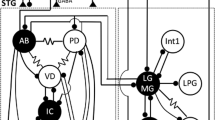Summary
-
1.
InJasus lalandii the activity of the central pattern generator of the pyloric motor output (the pyloric CPG) has been studied in intact free animals by electromyographic recording of the pyloric muscles (Fig. 2).
-
2.
Two patterns of activity (pattern 1 and pattern 2) can be observed. Each pattern corresponds to a specific behavioural situation: pattern 1 is only observed in unfed lobsters and feeding invariably produces a switch from pattern 1 to pattern 2 (Fig. 3).
-
3.
The two pyloric patterns differ in the period of the cycle (Fig. 4), the burst duration of the constrictors (Fig. 5), the latency of firing of the constrictors in the cycle (Fig. 6) and the phase of the constrictors in the cycle (Fig. 7). Correlation between period and constrictor latency is weak in pattern 1 and strong in pattern 2 (Fig. 8).
-
4.
The two pyloric patterns can be recorded from in vitro preparations only when the stomatogastric ganglion (i.e. the CPG) is connected to the more rostral commissural ganglia (Fig. 9).
-
5.
At least in pattern 1, cycling of the constrictors can occur when the dilators (known as pacemakers in the CPG) are silent (Fig. 10).
-
6.
For these reasons, we concluded that a commissural oscillator could be participating in the organization of the pyloric output. However, the synaptic relationships which exist between the motor neurones (i.e. the CPG) cannot be neglected (Fig. 11) and this suggests that, in the intact animal, the motor output is organized by the cooperation of a premotor oscillator and a motor oscillator.
Similar content being viewed by others
Abbreviations
- CPG :
-
central pattern generator
- CPO :
-
commissural pyloric oscillator
- STG :
-
stomatogastric ganglion
- CG :
-
commissural ganglion
- stn :
-
stomatogastric nerve
- PD,AB :
-
dilator neurones of the pyloric network
- LP,PY :
-
constrictor neurones of the pyloric network
- D :
-
dilator muscles
- C 1 :
-
first constrictor muscles
- C 2 :
-
second constrictor muscles
References
Altman J (1982) The role of sensory inputs in insect flight motor pattern generation. Trends Neurosci 5:257–260
Delcomyn F (1980) Neural basis of rhythmic behavior in animals. Science 210:492–498
Dickinson PS, Nagy F (1983) Control of a central pattern generator by an identified modulatory interneurone in Crustacea. II. Induction and modification of plateau properties in pyloric neurones. J Exp Biol 105:59–82
Fentress JC (1976) Simpler networks and behavior. Sinauer, Sunderland (Massachusetts)
Grillner S (1977) On the neural control of movement. A comparison of different basic rhythmic behaviors. In: Stent GS (ed) Function and formation of neural systems. Dahlem Konferenzen, Berlin, pp 197–224
Holst E von (1935) Erregungsbildung und Erregungsleitung im Fischrückenmark. Pflügers Arch 235:345–359
Maynard DM (1972) Simpler networks. Ann NY Acad Sci 193:59–72
Maynard DM, Dando MR (1974) The structure of the stomatogastric neuromuscular system inCallinectes sapidus, Homarus americanus andPanulirus argus. Philos Trans R Soc Lond [Biol] 268:161–220
Maynard DM, Selverston AI (1975) Organization of the stomatogastric ganglion of the spiny lobster. IV. The pyloric system. J Comp Physiol 100:161–182
Miller JP, Selverston AI (1982) Mechanisms underlying pattern generation in lobster stomatogastric ganglion as determined by selective inactivation of identified neurons. II Oscillatory properties of pyloric neurons. J Neurophysiol 48:1378–1391
Morris J, Maynard DM (1970) Recording from the stomatogastric nervous system in intact lobsters. Comp Biochem Physiol 33:969–974
Moulins M, Cournil I (1982) All or none control of the bursting properties of the pacemaker neurons of the lobster pyloric pattern generator. J Neurobiol 13:447–458
Moulins M, Nagy F (1983) Control of integration by extrinsic inputs in the crustacean pyloric circuit. J Physiol Paris 78:739–748
Nagy F (1981) Etude de l'expression d'activités motrices rythmiques organisées par des générateurs paucineuroniques du systéme nerveux stomatogastrique des crustacés décapodes. Flexibilité intrinsèque aux réseaux moteurs; contrôle par les centres supérieurs; contrôle proprioceptif. Thése d'Etat de l'Université de Bordeaux I
Raper JA (1979) Non-impulse mediated transmission during the generation of a cyclic motor program. Science 205:304–306
Rezer E, Moulins M (1980) Modalités d'expression du générateur du rythme pylorique chez les Crustacés: Analyse électromyographique. CR Acad Sci (Paris) 291:253–356
Robertson RM, Moulins M (1981) Oscillatory command input to the pattern generators of the crustacean stomatogastric ganglion. I. The pyloric rhythm. J Comp Physiol 143:453–463
Russel DF, Hartline DK (1978) Bursting neural networks: a reexamination. Science 200:453–456
Selverston AI (1980) Are central pattern generators understandable? Behav Brain Sci 3:535–571
Selverston AI, Miller JP (1980) Mechanism underlying pattern generation in lobster stomatogastric ganglion as determined by selective inactivation of identified neurons. I. Pyloric system. J Neurophysiol 44:1102–1121
Author information
Authors and Affiliations
Rights and permissions
About this article
Cite this article
Rezer, E., Moulins, M. Expression of the crustacean pyloric pattern generator in the intact animal. J. Comp. Physiol. 153, 17–28 (1983). https://doi.org/10.1007/BF00610338
Accepted:
Issue Date:
DOI: https://doi.org/10.1007/BF00610338



